Commercial Fisheries Part 4 – The Basics of bait
I’M GOING TO take a brief look at the vast subject of bait; pellets, sweetcorn, luncheon meat, bread, maggots, casters, worms, just a few of the many effective types of bait on commercial waters.
To get the best out of these baits, you need to understand not only what baits are effective but also when they are effective. Also, different species respond in different ways to various baits. This can help you select one species in favour of another, and make your fishing more interesting.
Pellets
In the last decade an entire industry has sprung up to cater for the use of pellets as bait. You could be forgiven for thinking that pellets are the only worthwhile bait on this type of water. Hardly true, but ignore them at your peril. Pellets are a cheap, convenient and brilliant bait, and here to stay. Originally developed from feed pellets used to grow on rainbow trout, anglers have used them for at least thirty years. Initially, anglers broke them down and mixed them into a stiff paste.
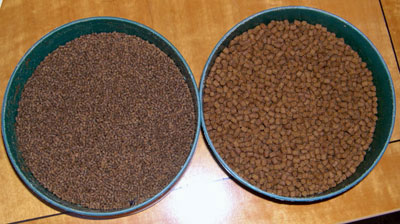
Pellets – ignore them at your peril
Thinking anglers developed the use of bait bands around a decade ago. This breakthrough revolutionised the use of pellets as hookbait. Simply a narrow rubber band like a slim float rubber, these hold the pellet onto the hook. The disadvantage is that it is fiddly to put the pellet into the band although there are tools to help you do it. What was wanted was a method of hooking the pellets directly on the hook. Anglers didn’t have to wait long.
Bait manufacturers next developed the expander pellet. You use a pump to force the air out of the expanded pellets and replace it with water. This results in a spongy pellet. Bait manufacturers have now introduced pots of ready expanded ‘hookable’ pellets. These come in a variety of flavours; my favourites are strawberry and Scopex.
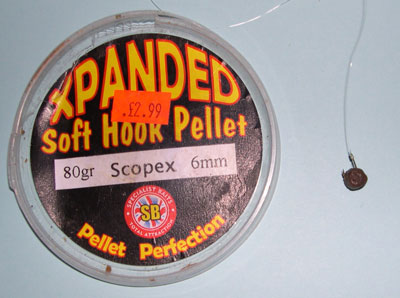
Expander Pellets
For the beginner these pots of hookable baits are a godsend. You could do far worse than obtain a couple of pots in the 4mm and 6mm sizes, plus a kilo bag of 3mm feed pellets. The only important factor in choosing the hookbait is that the pellets are sinking rather than floating. Ensure that the water that you intend fishing does not have any special rules saying that you may only use their own brand pellets; if so then you will have to comply.
So what fish are these pellets effective for? And at what time of year? Obviously carp, and in no particular order, tench, crucians, bream and roach.
Given mild conditions pellets can be used effectively from spring right through to late autumn. During the winter they are less effective but in the right conditions can still score. I find micro-pellets (2mm) a useful winter feed bait using them sparingly.
It is during the warmer months that pellets really score though. The great thing about them is that you don’t need huge quantities, and accurate feeding of just a small amount on a regular basis is a good starting point for the novice on this type of water. The emphasis is on regular though. That’s not a huge handful every half an hour but half a dozen pellets once a minute.
Favoured hook sizes – 16 to 12
Maggots
For the colder months of the year one bait remains top favourite; the old standby, maggots. In all but the very coldest of conditions maggots can produce bites when most baits fail. The disadvantage of using maggots in cold conditions is that you will need to fish a small hook with fine lines to get the best out of them. Certainly a smaller hook than the ones you can get away with using pellets. But this is a bait that is always worth considering from late autumn until the water warms up again in spring.
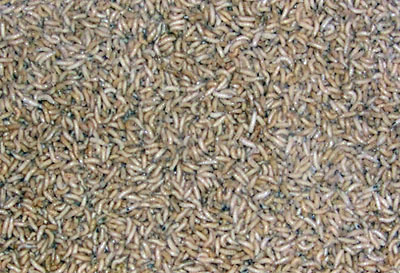
The old standby – maggots
During the summer months maggots can be effective but on many waters you may find them attracting too many unwanted small fish like little roach. One exception is that on waters that have chub in them maggots fished on the drop using a waggler float can be effective. This will work provided that the feeding is accurate and constant, probably using a catapult, and that the bait presentation is good enough to fool the chub. This means a carefully shotted float with just a few tiny shot down the line so that the bait sinks naturally. I like to fish with double maggot whenever I can though there are times when single maggot is more effective.
Favoured hook sizes – 22 to 18
Casters
Closely related to maggots but effective in a different way, don’t ignore casters when it comes to this type of fishing. Casters remain a supreme bait for catching the better roach.
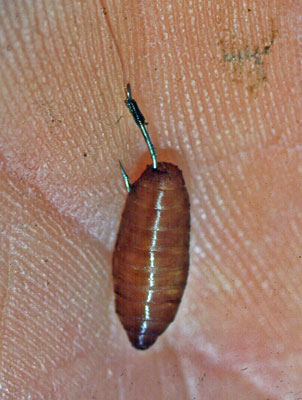
Caster – the supreme roach bait
Casters will work all year round but I’ve done best with them in the summer and autumn when the roach fishing is often at its best. This is a delicate style of fishing requiring finesse and a bit of stealth. Pole fishing is ideal for achieving the sort of presentation that big roach need if they are to be fooled, and for the angler weary of hauling carp, roach fishing can be just the tonic, assuming there are some decent samples present. I particularly enjoy fishing right up in the water for big roach with casters in summer but laying on can also work. It is often surprising just how big a roach are present once you actually try to catch them. Lightweight waggler fishing can also work.
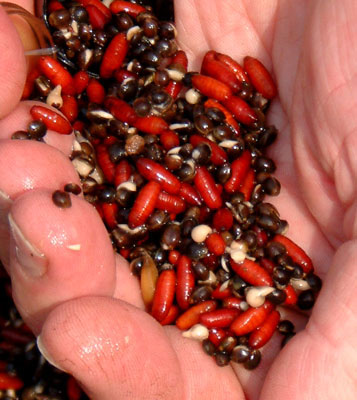
Casters – mix them 50/50 with hempseed
Generally, there is no need for huge quantities for this type of fishing; even a pint will suffice. I will cover this method in more detail later in the series. Try using hempseed mixed in 50/50 with your casters. This is particularly true in the heat of summer, and given a bit of patience, the better roach can end up taking the hemp on the hook as well. Though don’t be surprised if the carp muscle in!
Favoured hook sizes – 20 to 16
Sweetcorn
Sweetcorn is another very convenient bait and one that catches carp all year round, retaining its effectiveness in all but the coldest of conditions. In summer it can be useful in defeating the attentions of tiddlers, singling out the carp, tench, crucians, bream and better roach. From plain and simple corn to special flavoured versions from the tackle shop, and in a variety of sizes from mini niblets to large grains, whatever your choice it can be worth carrying some corn. It is a cheap bait that can be frozen for later use.
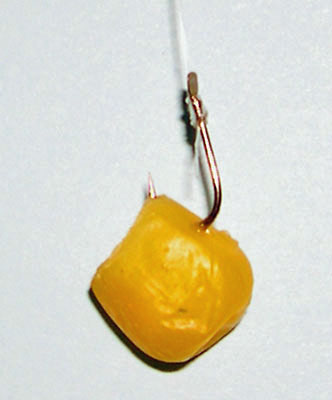
Sweetcorn – good all year round
Use corn with care because it is all too easy to overfeed the fish as it is a filling bait. I would go as far to say that it can be worth working on the basis of feeding literally three or four grains each time you catch a fish; that and no more. Sweetcorn is also best introduced very accurately, using a pole cup is ideal. I will cover this and other methods of feeding accurately later in the series.
One other consideration with corn is that being dense it can affect the shotting of your pole float, a grain being the equivalent of a no. 8 or no. 6 shot. You can use this to your advantage so by shotting the float correctly without the bait on and ensuring that the bait is just resting on the bottom. So fishing very slightly over depth the bait serves two purposes, one to anchor the float, and two, registering positive bites. Give it a try, and experiment a little with tiny adjustments to your depth.
Favoured hook sizes – 16 to 10
Luncheon Meat
Luncheon meat is a favourite bait that catches carp, bream and tench. Originally adapted from chub and barbel tactics on the rivers, meat was originally used simply as a large cube on a sizeable hook, say a size 8. But in recent years a new method has emerged for fishing with meat.
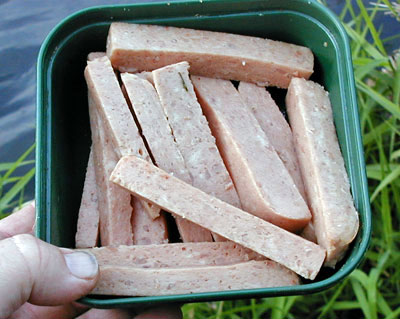
Luncheon Meat – best for warm weather
By using a tool to slice and dice the meat it is possible to feed meat effectively, especially using a large pole cup. Similarly, use a tool like a bread punch to punch out a large pellet of meat for the hook. Where anglers have used large quantities of meat with this method, sometimes the equivalent of several large tins, there are concerns that excess bait introduced can be detrimental to water quality. So whilst meat is a useful bait it is probably best to use it as a hookbait over pellets. I think that meat is best as a warm weather bait.
Favoured hook sizes – 14 to 8
Worms
Now for an old favourite, and in my opinion grossly underrated carp bait, the humble worm. Despite all the advances in hi-tech baits it’s surprising how few people even think of using worms on this type of water. One of my favourite ways of using worms is to put two small redworms on a size ten hook fished over the top of either some method mix groundbait or pellets.
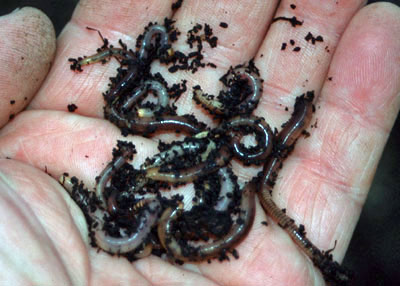
Worms – underrated
Another method for the more experienced that requires plenty of worms is to chop up a load of worms and casters and introduce them via a bait-dropper or a pole pot, and fish over the top with half a dendrobena or lobworm. This method can work for carp, or especially big perch. Though its very effectiveness for carp can actually prevent you catching the perch that you are targeting.
Favoured hook sizes – 16 to 8
Bread
Bread is a bait for the patient but fished carefully near to the inside shelf it is one of the deadliest baits around for crucians. That’s provided you can get past the carp, bream, tench, roach.
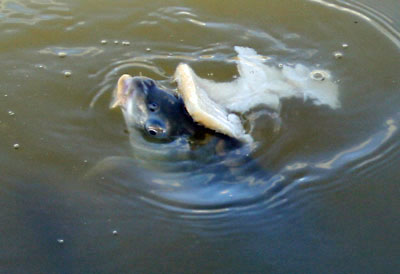
Bread – great for crucians, if you can get it past the carp!
I would recommend bread as a bait for the more experienced and confident angler as a bit of skill to put bread flake on the hook in a way that it’ll fluff up nicely in the water without falling off is required. It needs to be pinched ever so lightly onto the shank, but not so much that you get a solid lump of bread that no self respecting fish would touch. One way around hooking it on is to use a bread punch, and I’ll cover both these methods later in the series. Ground bait in both cases can be some proprietary groundbait, or even fishing it over some pellets. For me, this type of fishing is very much a thing of summer.
Favoured hook sizes (punch) – 18 to 14, (flake) – 14 to 8
Groundbait
For the most part, given the multitude of baits that can be used above to feed the swim there isn’t that much need for groundbait on this type of fishery (check that it’s allowed). But on occasion, and provided it is allowed, groundbait can be useful, indeed essential, for certain styles of fishing. The two main ones are fishing the method, and feeder tactics for bream, tench etc. The Method consists of a heavy aerodynamic feeder around which a fishmeal groundbait is moulded. With a short hook link of as little as two inches and baits that include corn, pellet, even dead maggots, this method can be deadly. Accurate casting is a must but carp can be suckers for this way of fishing.
Paste (boilies?)
I’ve already mentioned trout pellet paste which remains a useful bait. Additionally there are all sorts of proprietary paste mixes that can be used to catch fish on this type of water. Some are not that different from using a boilie mix only in that it is much softer. It is certainly worth trying a paste, especially if the water you are fishing has carp that are bigger than a few pounds. From here it is but a short step to using boilies. At this point I am straying into the world of specialised carp fishing, and it might be an idea to gently bring this article to a close before I find that I need to write a whole new series.
Two or three would suffice, but it’s fun trying different baits
As you can see there are many and varied possible baits that will all catch fish in the right circumstances.
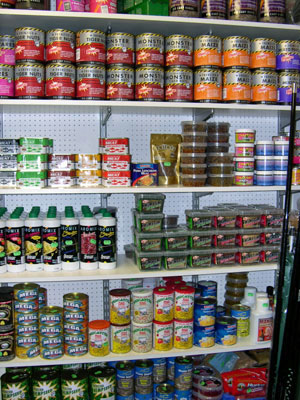
Try different baits – there are plenty to choose from
It is probably true that using just two or three of the many that I’ve listed would suffice for your needs but it can be fun to try out different baits from time to time; one that I must try again having failed with it previously is green-lip mussels, a potentially fine tench bait.
In Part 5 – Buying and elasticating a pole.










